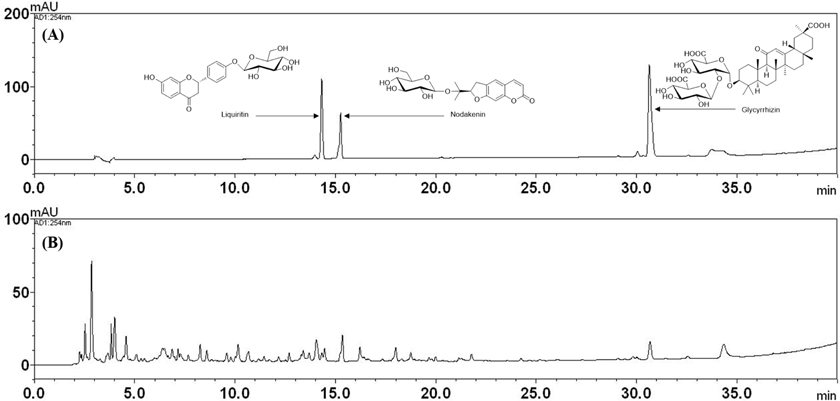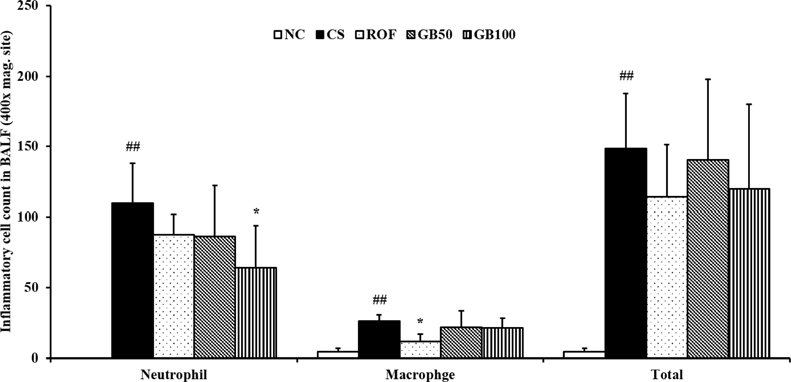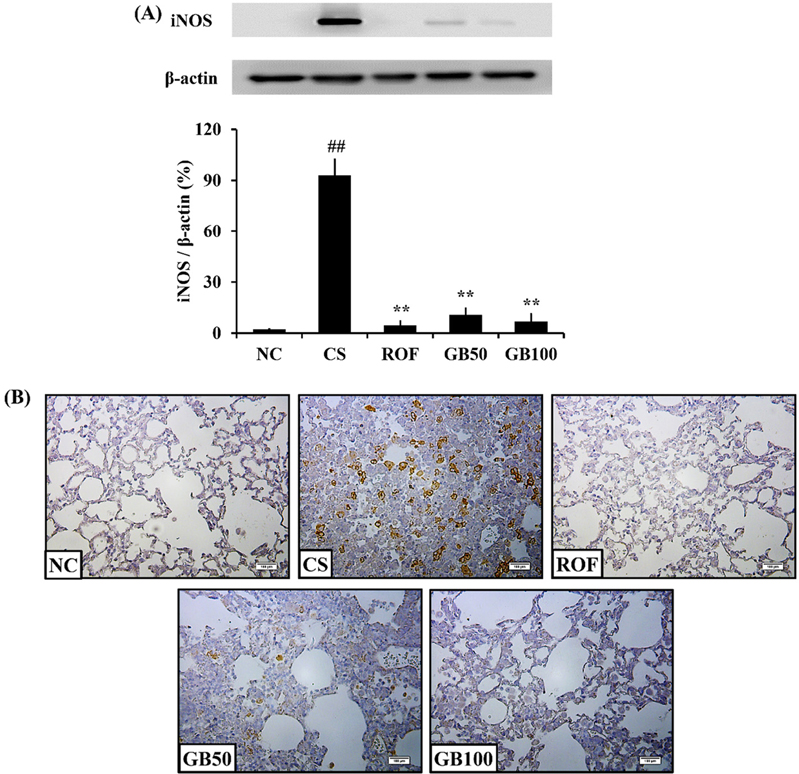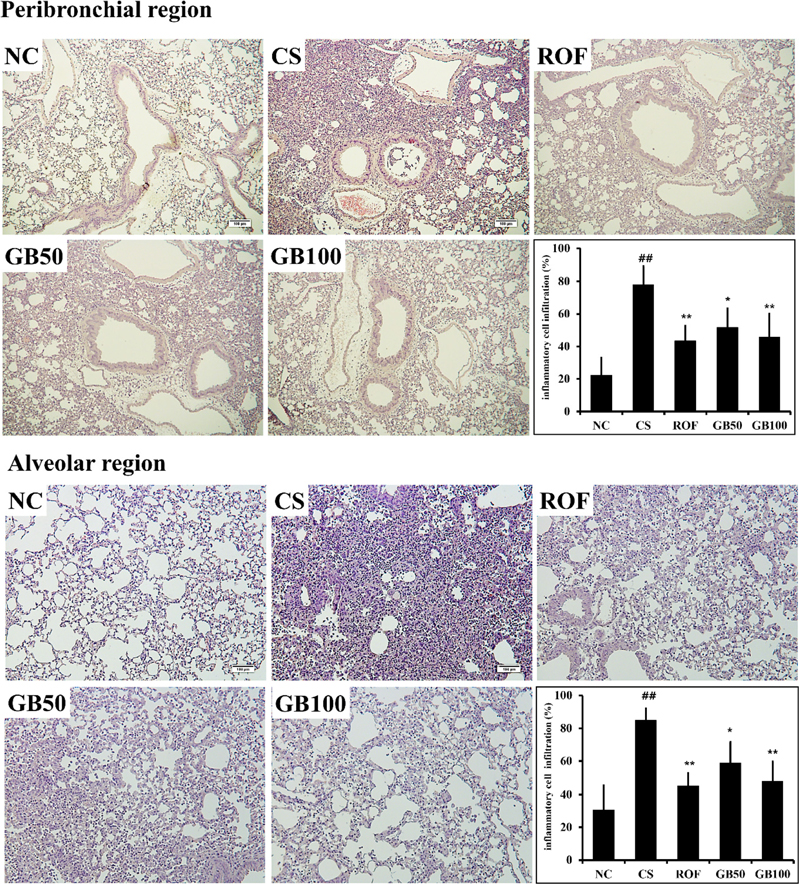Lab Anim Res.
2018 Sep;34(3):92-100. 10.5625/lar.2018.34.3.92.
Protective effect of water extract of guibi-tang against pulmonary inflammation induced by cigarette smoke and lipopolysaccharide
- Affiliations
-
- 1College of Veterinary Medicine (BK21 Plus Project Team), Chonnam National University, Gwangju, Korea. dvmmk79@gmail.com
- 2K-herb Research Center, Korea Institute of Oriental Medicine, Daejeon, Korea.
- KMID: 2420821
- DOI: http://doi.org/10.5625/lar.2018.34.3.92
Abstract
- Water extract of guibi-tang (GB), a traditional Chinese, Japanese, and Korean herbal medicine, is used to treat memory impairment, insomnia, and peptic ulcers. The aim of this study was to investigate the protective effects of GB on pulmonary inflammation induced by cigarette smoke (CS) and lipopolysaccharide (LPS). C57BL/6 mice were used to develop a pulmonary inflammation model by exposing them to CS for 1 h per day for 7 days. LPS was intranasally administered to mice under mild anesthesia on day 5. GB was administered 1 h before CS exposure at doses of 50 or 100 mg/kg for 7 days. Our results showed that GB suppressed the CS and LPS induced elevation in inflammatory cell counts in the bronchoalveolar lavage fluid (BALF), with significant reductions in protein, tumor necrosis factor (TNF)-α, and interleukin (IL)-6 levels. Histological studies revealed that GB decreased the inflammatory cell infiltration into lung tissue caused by CS- and LPS-exposure. GB also significantly decreased the CS and LPS-induced expression of inducible nitric oxide synthase (iNOS) in the lung tissue. Taken together, GB effectively attenuated airway inflammation caused by CS and LPS. These results indicate that GB is a potential therapeutic herbal formula for pulmonary inflammatory disease.
MeSH Terms
-
Anesthesia
Animals
Asian Continental Ancestry Group
Bronchoalveolar Lavage Fluid
Cell Count
Herbal Medicine
Humans
Inflammation
Interleukins
Lung
Memory
Mice
Nitric Oxide Synthase Type II
Peptic Ulcer
Pneumonia*
Sleep Initiation and Maintenance Disorders
Smoke*
Tobacco Products*
Tumor Necrosis Factor-alpha
Water*
Interleukins
Nitric Oxide Synthase Type II
Smoke
Tumor Necrosis Factor-alpha
Water
Figure
Reference
-
1. Scherer PM, Chen DL. Imaging Pulmonary Inflammation. J Nucl Med. 2016; 57(11):1764–1770.
Article2. Abdul Roda M, Sadik M, Gaggar A, Hardison MT, Jablonsky MJ, Braber S, Blalock JE, Redegeld FA, Folkerts G, Jackson PL. Targeting prolyl endopeptidase with valproic acid as a potential modulator of neutrophilic inflammation. PLoS One. 2014; 9(5):e97594.
Article3. Boskabady MH, Gholami Mhtaj L. Effect of the Zataria multiflora on systemic inflammation of experimental animals model of COPD. Biomed Res Int. 2014; 2014:802189.4. Liu H, Ren J, Chen H, Huang Y, Li H, Zhang Z, Wang J. Resveratrol protects against cigarette smoke-induced oxidative damage and pulmonary inflammation. J Biochem Mol Toxicol. 2014; 28(10):465–471.
Article5. Liu MH, Lin AH, Lee HF, Ko HK, Lee TS, Kou YR. Paeonol attenuates cigarette smoke-induced lung inflammation by inhibiting ROS-sensitive inflammatory signaling. Mediators Inflamm. 2014; 2014:651890.
Article6. Hsiao HM, Sapinoro RE, Thatcher TH, Croasdell A, Levy EP, Fulton RA, Olsen KC, Pollock SJ, Serhan CN, Phipps RP, Sime PJ. A novel anti-inflammatory and pro-resolving role for resolvin D1 in acute cigarette smoke-induced lung inflammation. PLoS One. 2013; 8(3):e58258.
Article7. Nikota JK, Shen P, Morissette MC, Fernandes K, Roos A, Chu DK, Barra NG, Iwakura Y, Kolbeck R, Humbles AA, Stampfli MR. Cigarette smoke primes the pulmonary environment to IL-1α/CXCR-2-dependent nontypeable Haemophilus influenzae-exacerbated neutrophilia in mice. J Immunol. 2014; 193(6):3134–3145.
Article8. Grommes J, Soehnlein O. Contribution of neutrophils to acute lung injury. Mol Med. 2011; 17(3-4):293–307.
Article9. Berry M, Hargadon B, Morgan A, Shelley M, Richter J, Shaw D, Green RH, Brightling C, Wardlaw AJ, Pavord ID. Alveolar nitric oxide in adults with asthma: evidence of distal lung inflammation in refractory asthma. Eur Respir J. 2005; 25(6):986–991.
Article10. Bhattacharjee A, Prasad SK, Pal S, Maji B, Banerjee A, Das D, Bose A, Chatterjee N, Mukherjee S. Possible involvement of iNOS and TNF-α in nutritional intervention against nicotine-induced pancreatic islet cell damage. Biomed Pharmacother. 2016; 84:1727–1738.
Article11. Lee H, Park JR, Kim EJ, Kim WJ, Hong SH, Park SM, Yang SR. Cigarette smoke-mediated oxidative stress induces apoptosis via the MAPKs/STAT1 pathway in mouse lung fibroblasts. Toxicol Lett. 2016; 240(1):140–148.
Article12. Gupta I, Ganguly S, Rozanas CR, Stuehr DJ, Panda K. Ascorbate attenuates pulmonary emphysema by inhibiting tobacco smoke and Rtp801-triggered lung protein modification and proteolysis. Proc Natl Acad Sci USA. 2016; 113(29):E4208–E4217.
Article13. Lee YM, Lee YR, Kim CS, Jo K, Sohn E, Kim JS, Kim J. Effect of Guibi-Tang, a Traditional Herbal Formula, on Retinal Neovascularization in a Mouse Model of Proliferative Retinopathy. Int J Mol Sci. 2015; 16(12):29900–29910.
Article14. Lee MY, Seo CS, Kim JY, Shin HK. Genotoxicity evaluation of Guibi-Tang extract using an in vitro bacterial reverse mutation assay, chromosome aberration assay, and in vivo micronucleus test. BMC Complement Altern Med. 2014; 14:215.
Article15. Oh MS, Huh Y, Bae H, Ahn DK, Park SK. The multi-herbal formula Guibi-tang enhances memory and increases cell proliferation in the rat hippocampus. Neurosci Lett. 2005; 379(3):205–208.
Article16. Yim NH, Kim A, Liang C, Cho WK, Ma JY. Guibitang, a traditional herbal medicine, induces apoptotic death in A431 cells by regulating the activities of mitogen-activated protein kinases. BMC Complement Altern Med. 2014; 14:344.
Article17. Abbott-Banner KH, Page CP. Dual PDE3/4 and PDE4 inhibitors: novel treatments for COPD and other inflammatory airway diseases. Basic Clin Pharmacol Toxicol. 2014; 114(5):365–376.
Article18. Kubo S, Kobayashi M, Iwata M, Miyata K, Takahashi K, Shimizu Y. Anti-neutrophilic inflammatory activity of ASP3258, a novel phosphodiesterase type 4 inhibitor. Int Immunopharmacol. 2012; 12(1):59–63.
Article19. Yoshida T, Tuder RM. Pathobiology of cigarette smoke-induced chronic obstructive pulmonary disease. Physiol Rev. 2007; 87(3):1047–1082.
Article20. John-Schuster G, Günter S, Hager K, Conlon TM, Eickelberg O, Yildirim AÖ. Inflammaging increases susceptibility to cigarette smoke-induced COPD. Oncotarget. 2016; 7(21):30068–30083.
Article21. Leberl M, Kratzer A, Taraseviciene-Stewart L. Tobacco smoke induced COPD/emphysema in the animal model-are we all on the same page? Front Physiol. 2013; 4:91.
Article22. Li Y, Yu G, Yuan S, Tan C, Lian P, Fu L, Hou Q, Xu B, Wang H. Cigarette Smoke-Induced Pulmonary Inflammation and Autophagy Are Attenuated in Ephx2-Deficient Mice. Inflammation. 2017; 40(2):497–510.
Article23. D'hulst AI, Vermaelen KY, Brusselle GG, Joos GF, Pauwels RA. Time course of cigarette smoke-induced pulmonary inflammation in mice. Eur Respir J. 2005; 26(2):204–213.24. O'Donnell R, Breen D, Wilson S, Djukanovic R. Inflammatory cells in the airways in COPD. Thorax. 2006; 61(5):448–454.25. Rovina N, Koutsoukou A, Koulouris NG. Inflammation and immune response in COPD: where do we stand? Mediators Inflamm. 2013; 2013:413735.
Article26. Karimi K, Sarir H, Mortaz E, Smit JJ, Hosseini H, De Kimpe SJ, Nijkamp FP, Folkerts G. Toll-like receptor-4 mediates cigarette smoke-induced cytokine production by human macrophages. Respir Res. 2006; 7:66.
Article27. Teasdale JE, Hazell GG, Peachey AM, Sala-Newby GB, Hindmarch CC, McKay TR, Bond M, Newby AC, White SJ. Cigarette smoke extract profoundly suppresses TNFα-mediated proinflammatory gene expression through upregulation of ATF3 in human coronary artery endothelial cells. Sci Rep. 2017; 7:39945.
Article28. Hubeau C, Kubera JE, Masek-Hammerman K, Williams CM. Interleukin-6 neutralization alleviates pulmonary inflammation in mice exposed to cigarette smoke and poly(I:C). Clin Sci (Lond). 2013; 125(10):483–493.
Article29. Wei J, Xiong XF, Lin YH, Zheng BX, Cheng DY. Association between serum interleukin-6 concentrations and chronic obstructive pulmonary disease: a systematic review and meta-analysis. PeerJ. 2015; 3:e1199.
Article30. He JQ, Foreman MG, Shumansky K, Zhang X, Akhabir L, Sin DD, Man SF, DeMeo DL, Litonjua AA, Silverman EK, Connett JE, Anthonisen NR, Wise RA, Paré PD, Sandford AJ. Associations of IL6 polymorphisms with lung function decline and COPD. Thorax. 2009; 64(8):698–704.
Article31. Malerba M, Radaeli A, Olivini A, Damiani G, Ragnoli B, Montuschi P, Ricciardolo FL. Exhaled nitric oxide as a biomarker in COPD and related comorbidities. Biomed Res Int. 2014; 2014:271918.
Article32. Hesslinger C, Strub A, Boer R, Ulrich WR, Lehner MD, Braun C. Inhibition of inducible nitric oxide synthase in respiratory diseases. Biochem Soc Trans. 2009; 37(Pt 4):886–891.
Article33. Agustí A, Morlá M, Sauleda J, Saus C, Busquets X. NF-kappaB activation and iNOS upregulation in skeletal muscle of patients with COPD and low body weight. Thorax. 2004; 59(6):483–487.34. Wright JL, Zhou S, Churg A. Pulmonary hypertension and vascular oxidative damage in cigarette smoke exposed eNOS(-/-) mice and human smokers. Inhal Toxicol. 2012; 24(11):732–740.35. Li XQ, Cai LM, Liu J, Ma YL, Kong YH, Li H, Jiang M. Liquiritin suppresses UVB-induced skin injury through prevention of inflammation, oxidative stress and apoptosis through the TLR4/MyD88/NF-κB and MAPK/caspase signaling pathways. Int J Mol Med. 2018; 42(3):1445–1459.
Article36. Guan Y, Li FF, Hong L, Yan XF, Tan GL, He JS, Dong XW, Bao MJ, Xie QM. Protective effects of liquiritin apioside on cigarette smoke-induced lung epithelial cell injury. Fundam Clin Pharmacol. 2012; 26(4):473–483.
Article37. Xiong Y, Wang J, Yu H, Zhang X, Miao C, Ma S. The effects of nodakenin on airway inflammation, hyper-responsiveness and remodeling in a murine model of allergic asthma. Immunopharmacol Immunotoxicol. 2014; 36(5):341–348.
Article38. Ram A, Mabalirajan U, Das M, Bhattacharya I, Dinda AK, Gangal SV, Ghosh B. Glycyrrhizin alleviates experimental allergic asthma in mice. Int Immunopharmacol. 2006; 6(9):1468–1477.
Article39. Cai X, Wang X, Li J, Chen S. Protective effect of glycyrrhizin on myocardial ischemia/reperfusion injury-induced oxidative stress, inducible nitric oxide synthase and inflammatory reactions through high-mobility group box 1 and mitogen-activated protein kinase expression. Exp Ther Med. 2017; 14(2):1219–1226.
Article
- Full Text Links
- Actions
-
Cited
- CITED
-
- Close
- Share
- Similar articles
-
- An Experimental Study on the Protective Effects of Ginseng Extract to Oxygen Toxicity
- Effect of Pyunkang-tang on Inflammatory Aspects of Chronic Obstructive Pulmonary Disease in a Rat Model
- HemoHIM, a herbal preparation, alleviates airway inflammation caused by cigarette smoke and lipopolysaccharide
- Role of AMP-Activated Protein Kinase (AMPK) in Smoking-Induced Lung Inflammation and Emphysema
- The Comparison of the Effect of Cigarette and Stop Smoking-aiding Cigarette on Release of IL-6 from Bronchial Epithelial Cell






